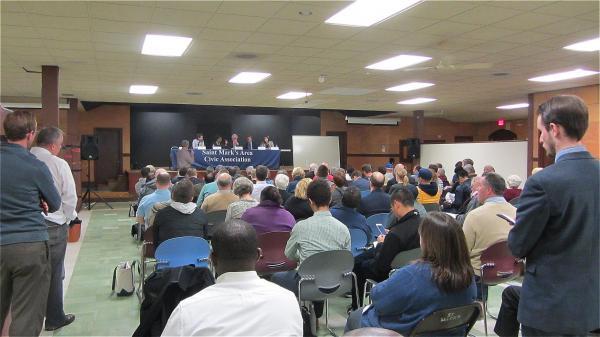May 4, 2017

The scene inside St. Mark's Church hall on Tuesday evening. Jennifer Smith photo
Community members and housing experts engaged in a discussion on development and Dorchester’s trajectory during a wide-ranging forum in the basement hall of St Mark’s Church on Tuesday night. Faced with housing pressures coming to bear on the increasingly desirable neighborhood, attendees grappled with forces shaping the economic reality of living and building in Boston.
Around 150 people came prepared for a forum entitled “Beyond the Buzzwords: Shaping the Future of Housing & Development in Dorchester” that was hosted by the St. Mark’s Area Civic Association. The conversation did not delve deeply into specific projects; the gathering was more an opportunity to address the needs for, and the consequences of, new housing in a cramped city.
Boston’s primary pressures are driven by its booming economy and aging workforce, noted Tim Reardon, the director of data service for the Metropolitan Area Planning Council. “I know a lot of folks in the room really love their neighborhood, they want their neighborhood to stay the way it is,” he said. “And yet, if you look at this from a regional perspective, the construction of new housing is really critical to the entire metro Boston region for our economic future as a region.”
As Baby Boomers age, Reardon’s data show, the city will need to bring in new workers to offset their loss. The Boomers make up 49 percent of the region’s labor force, he said, and by 2030, more than 1 million workers born before 1970 – a full 40 percent of the region’s workers – will leave the workforce. At least 800,000 new workers filling almost 492,000 housing units would be needed to fill that void, Reardon said, and “we are not growing or importing enough young workers to fill those jobs.”
To bolster the economy and provide enough new tax revenue, the metropolitan area has to attract more workers, he said.
Boston is projected to grow by 17 percent by 2030, Reardon said. “If we don’t develop enough places for young workers to move in, all we’ll see is a growing number of seniors, fewer employed residents here to pay taxes and support city services, and it could create a financial challenge for the city if housing growth is limited to such an extent.”
Engagement between state and city officials is needed to spearhead policy to help address this crisis, said state Sen. Linda Dorcena Forry. The 351 cities and towns in the Commonwealth have to meet a 10 percent bar by law for affordable units, which Boston clears with its 25 percent affordable. Less than half of the remaining municipalities meet that standard.
“We have to do a lot more work to generate a lot more housing that’s affordable,” she said, referencing the 2016 state Senate report offering potential fixes for the housing crisis released during Forry’s tenure as housing chair.
Major sites in Boston are ripe for new investment, she said, highlighting among other projects the $153 million Winthrop Square “shadow” agreement that would benefit outlying neighborhoods, and the opportunity for a competitive process on Columbia Point, where the fate of major parcels like the Bayside site and the adjacent Boston Globe property remain cloudy.
“If there’s property, and there’s a lot of vacant units as well that aren’t on the market,” she said, “how can we make sure that gets developed to put people into housing?”
Forum moderator Tom Callahan, the executive director of the Massachusetts Affordable Housing Alliance (MAHA), offered a note on using area median income to determine affordability. The median pulls from around Greater Boston, including into its average wealthier suburbs when setting the base rate. But unless the city wants wealthier areas to create their own individualized AMI, housing priorities should be focused on building homes at the 30 percent AMI level rather than asking for an overhaul of the regional measure to more accurately reflect specific neighborhoods, he said.
Jim Greely & Cecilia Nardi with the Boston Planning and Development Agency (BPDA), reviewed the department’s renewed commitment to community process. A walk/bike trip through the “PLAN: Glover’s Corner” site is scheduled for tonight (Thursday), for residents and stakeholders to examine the Dorchester Avenue corridor that is now poised for rezoning.
Questions from the floor dealt with fears about displacement and the loss of affordable living options in the neighborhood. One woman posed the biggest applause line of the night: “Who are we building the city for? For the people who live here or for the people you hope will come here?”
Panelists did not offer solutions so much as insight into the mechanisms behind development -- the impact of affordable housing policy, the need for new units, community-up rezoning.
Drawing from his history in Dorchester, Jim Keefe of Trinity Financial , which developed the Carruth building and the new Treadmark building near Ashmont station, compared the city’s current growing pains with the decades of living with the impacts of redlining, white flight, and busing.
“So tonight, as we grapple with the issues of development, where there are deeply felt concerns about traffic, parking, and destiny, I’m going to try to remind people that there are good problems and there are bad problems,” he said. “Based upon my lifetime here in Dorchester, these seem like good ones to have.”
Bring everyone to the table, he said. There are upsides to density when it comes to public safety and patronage of local businesses. Transit-oriented developments can be a reason to reduce car ownership, he noted, and the Red Line offers a transit spine to Dorchester that isn’t mirrored to the same extent in neighborhoods like East Boston.
Most of the city is reaching a level of completion from a development perspective, Keefe said, “and development in the city is going to go some place. And the next logical place is farther down the Red Line here.”
Villages:
Topics:


